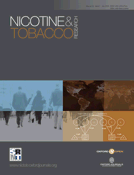-
Views
-
Cite
Cite
Elisa K. Tong, Richard Strouse, John Hall, Martha Kovac, Steven A. Schroeder, National survey of U.S. health professionals’ smoking prevalence, cessation practices, and beliefs, Nicotine & Tobacco Research, Volume 12, Issue 7, July 2010, Pages 724–733, https://doi.org/10.1093/ntr/ntq071
Close - Share Icon Share
Abstract
Tobacco dependence treatment efforts have focused on primary care physicians (PCPs), but evidence suggests that they are insufficient to help most smokers quit. Other health professionals also frequently encounter smokers, but their smoking prevalence, cessation practices, and beliefs are less well known.
The study included 2,804 subjects from seven health professional groups: PCPs, emergency medicine physicians, psychiatrists, registered nurses, dentists, dental hygienists, and pharmacists. Outcomes included self-reported smoking status, smoking cessation practices, and beliefs. Multivariate regression was used to examine factors associated with health professionals (except pharmacists) self-reportedly performing the “5 A’s”: asking, advising, assessing, assisting, or arranging follow-up about tobacco.
Health professionals have a low smoking prevalence (<6%), except nurses (13%). Many health professionals report asking (87.3%–99.5%) and advising (65.6%–94.9%) about smoking but much less assessing smokers’ interest (38.7%–84.8%), assisting (16.4%–63.7%), and arranging follow-up (1.3%–23.1%). Controlling for health professional and practice demographics, factors positively associated in the multivariate analyses with self-reportedly performing multiple components of the 5 A’s include awareness of the Public Health Service guidelines, having had cessation training, and believing that treatment was an important professional responsibility. Negative associations include the health professional being a current smoker, not being a PCP, being uncomfortable asking patients if they smoke, believing counseling was not an appropriate service, and reporting competing priorities.
U.S. health professionals report not fully performing the 5 A’s. The common barriers and facilitators identified may help inform strategies for increasing the involvement of all health professionals in conducting tobacco dependence treatments.






Comments